Or – “What The Publishers These Days Call A Great Jumping-On Point…”
I’ve commented many times on my great dislike of both the 90’s Ghost Rider revamp and the “Elvis-As-Hipster-Doofus” take that was the Nick Cage movie. As with many of my dislikes, it’s not out of sheer bastardry that I rage against the corporate machine, but because of my deep love of a DIFFERENT version of the character. I came into Johnny Blaze’s run as Ghost Rider late (with the last issue of that run, #81, actually) and worked my way backwards through his character history until I now have a complete run of the character’s solo appearances, his time with the Champions and all his team-ups. In all of those appearances, few artists have managed to capture the character the way Bob Budiansky did in the early 80’s. (Cue Rodrigo with ‘A Flock Of Seagulls.’)
Since the rule of writing is ‘Show, Don’t Tell,’ allow me to show you “Why Matthew Loves The Ghost Rider.”
 Ghost Rider #68
Ghost Rider #68
Written by ROGER STERN
Pencils by BOB BUDIANSKY
Inks by JOE RUBINSTEIN
Letters by DIANA ALBERS
Colors by GEORGE ROUSSOS
Published by MARVEL COMICS
Previously, on Ghost Rider: Johnny Blaze was a stunt motorcyclist, one of the best, until a random happenstance bonded him with a second life. For several years, he wandered the Earth, trying to calm the demon that raged within him, searching for something that would ease his torments. Having lost his World Championship, Johnny hooked up with the Quentin Carnival, a traveling circus where he found kindred spirits and a place to hone his skills. Never entirely comfortable with the monicker of “super-hero,” Johnny has also found it more and more difficult to control the Ghost Rider during his transformations, and has begun to actively fight becoming his alter ego AT ALL. Tortured, in fear of his own inner demons (literally, not in the wrestling connotation), and apparently bound to encounter weirdos and psychopaths at random intervals, all Johnny Blaze really wants is a moment of peace…
Our story begins on a dark and stormy night (TM Snoopy), as the doors of a small church creak open, surprising the priest inside. “Who’s there? Who is it?” cries the suddenly frightened man in the collar…
Unnerved by the stranger, worried that Johnny has come to rob him, the young father agrees to hear Johnny’s sins, saying that his confessional is open to all. “This is a bit complicated,” stammers Johnny, “I don’t know where to begin.” The art is lovely and moody, as Johnny tells of his childhood: dead mother, father a wandering cycle jockey in the Crash Simpson travelling stunt show, a nomad’s life at best. When his father died in the line of duty, young John was offered a new life by Crash himself…
Johnny and Roxanne were barely able to leap away from the inevitable (at least for comic books or Magnum, PI) explosion, but Rocky’s mother Mona ran to see if her daughter and adoptive son were all right, and was fatally injured in the explosion. Poor Mona had a last-minute deathbed request for Johnny…
Johnny is overcome with emotion remembering his surrogate mother, and the young priest tries to talk of faith. “DON’T TALK TO ME ABOUT FAITH!” cries a distraught Blaze before apologizing and continuing with his story. John became Crash’s most faithful and talented mechanic, and even practiced his own stunt-riding in secret for years as the show went on. But just as they hit the big time, booking Madison Square Garden for stunt show, a bitter Crash has another crushing blow for Blaze.
Heh. You have to love that reaction. It’s actually at the heart of the Ghost Rider dichotomy for me. To save his loved one (and, honestly, to save himself losing another parent) Johnny gathers up his various necronomicons and gewgaws (left over from an earlier rebellious period of his youth) and bargains to save the life of Crash Simpson… with the only coin he possesses, his own soul.
For the comic-book connosieurs in the audience, your eyes are not decieving you. That is, indeed, the Silver Surfer’s old nemesis Mephisto who answers Johnny’s plea. This story is the first time that we’re given the semi-retcon that Mephisto, the comic book devil/divorce attorney, is behind the transition. Previous versions of the story had only identified Blaze’s benefactor (malefactor?) as “Satan,” and the Marvel Universe has about eleventy-seven various goons who go by that name. His confidence boosted by Mephisto’s infernal boon, Johnny watches fearlessly as Crash Simpson headlined Madison Square Garden with a death-defying jump over 22 cars. Of course, the “defying” part is somewhat misleading, as Crash is killed when his motorcycle crashed into the vehicles well short of the closing ramp. (Some versions of the tale have Johnny immediately successfully completing the jump here, but it’s not necessary for tonight’s telling of the tale…) Johnny believes that Mephisto has lied to him, but the real truth is even more terrifying.
“Delusions?” laughs Johnny, obviously wishing that it were true, that he had only imagined his burden. The priest is in no position to understand exactly the kind of torment John Blaze has spent years enduring (for more reasons than one) but Johnny outlines it all for him in gruesome detail. At night, his skin and flesh boils away, leaving him a walking skeletal thing, a monstrous being engulfed in hellish flames, a creature who grows less and less manageable with every transmogrification…
“But what bothers me, father,” explains Johnny, his voice going cold, “is that sometimes I WANT him to get out.” As the priest wonders what sort of lunatic he’s trapped in the church with, Johnny explains that sometimes, when humanity’s worst aspects leave them in dire need of punishment, he wants to unleash the spirit of vengeance within, to let the demon punish the wicked. In fact, explains Blaze, that urge has brought him to this particular sanctuary on THIS VERY NIGHT…
His duplicity revealed, the false man of the cloth panicks, running from the the confessional, only to be followed by the Spirit of Vengeance. He tries shooting the Ghost Rider only to find his bullets useless against a creature of flame and bones. He even upends the heavy oaken altar onto the monster, only to have Ghost Rider effortlessly heft it over his head, laughing maniacally. “What a supreme jest!” the demon cries. “The Ghost Rider, upholding an artifact of the holy!” The fleeing criminal steals Johnny’s motorcycle, but quickly finds that Ghost Rider’s abilities make a mockery of the crude steel engine’s speed.
As the broken and battered killer lies on the railroad tracks, The Ghost Rider stalks up out of the night. The man fears that he’s going to be killed by the demon, but Ghost Rider laughs, placing a hand on his shoulder. “Death is TOO GOOD for the likes of you,” cackles the Ghost Rider, burning the killer with hellfire, forcing him to feel the pain of his many victims. The next morning, Johnny Blaze calls the authorities to take the shattered man into custody.
It’s a chilling ending, made even more so by the fact that, by this point in the book, Johnny has taken to fighting off the Ghost Rider with all his might, battling against the transformation. Indeed, this may be the last time that Johnny willfully transforms into the Ghost Rider until his book’s cancellation a year or two later. It’s a fitting sort of end for a petty thief and murderer, and a clear-cut win (albeit a very disconcerting one) for Ghost Rider.
The fascinating thing about the structure of this issue is that the real meat of the tale is in the framing sequence, allowing us to retell Ghost Rider’s origins (even working out some of the kinks that had made their way into the Marvel Universe in the ten years since Marvel Spotlight #5, and adding the twist of Mephisto’s culpability) while giving us a nice Twilight Zone “justice is served by supernatural means” riff at the end. Bob Budiansky’s art is reminiscent of a slight more angular Herb Trimpe, but his skeletal Ghost Rider manages to be both awesome and frightful at the same time, and is one of the first times I believed that he was a skeleton rather than a man wearing a full-head mask. Indeed, even years after reading it, elements of this story have stuck in my brain, and the tale itself is skillfully told. On television, episodes like this are called “bottle shows,” and can be a mixed bag, but here the limited cast gives us drama, important bits and pieces of character lore, and serves as the periodic re-imagining of origins that comics used to do every few years. Lately, we find that comic books retcon and deal with the consequences later. Roger Stern nailed this one, and this issue (indeed, the last 20 or so issues of Johnny Blaze’ run) are the reason why I hold the character in such high resolve. Ghost Rider #68 sticks the landing, and even has a couple of amazing “Hell, Yeah!” moments (witness the shadows during the transformation seen in the confessional) earning 5 out of 5 stars overall. Let’s see your Danny Ketch pull off something THIS awesome!
Faithful Spoilerite Question Of The Day: What single issues serve as individual testaments to characters that YOU love?




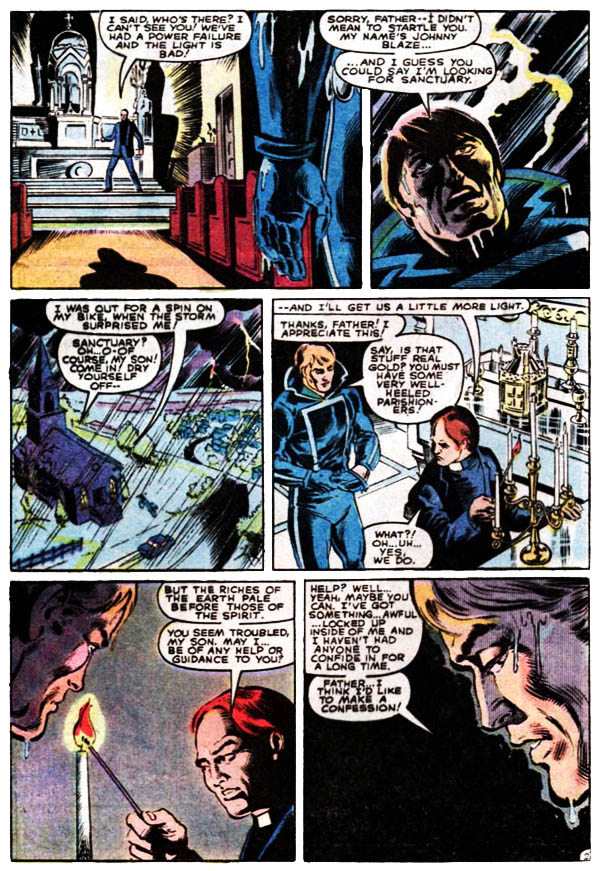

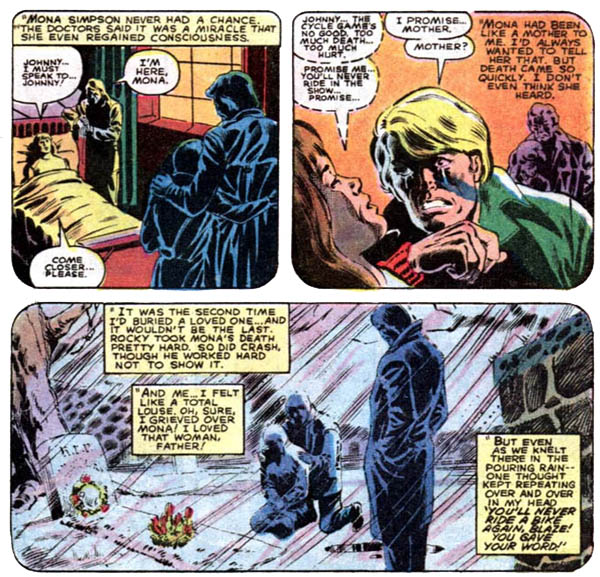



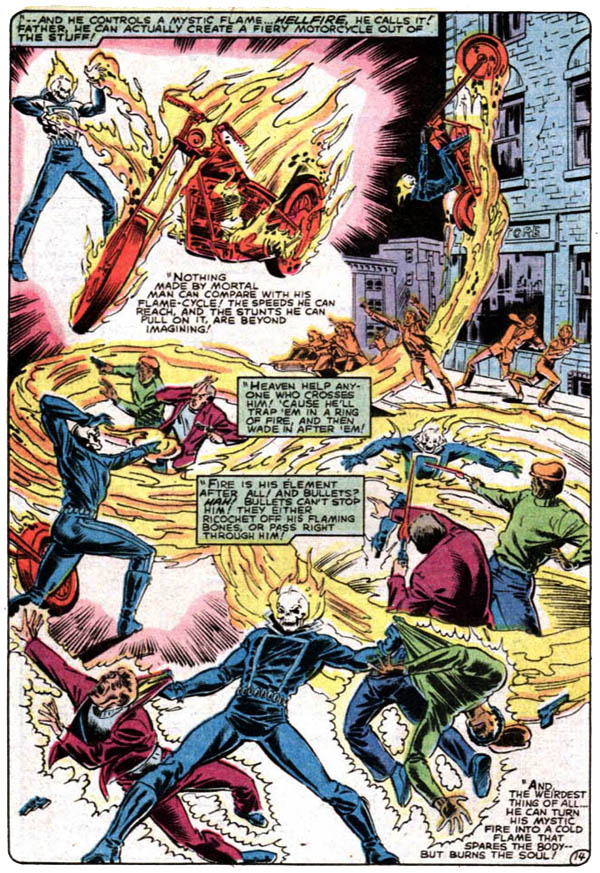
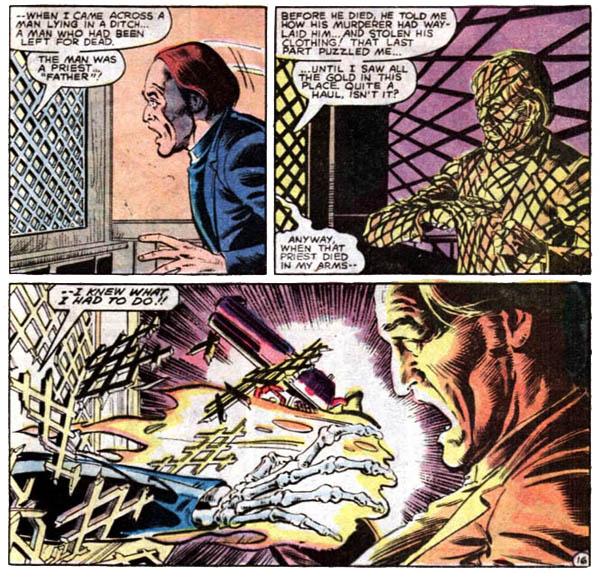
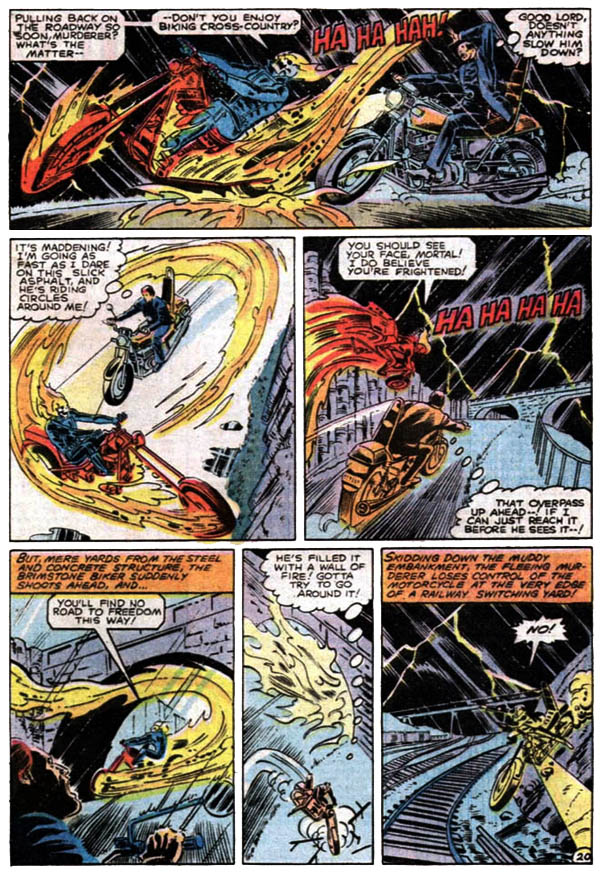
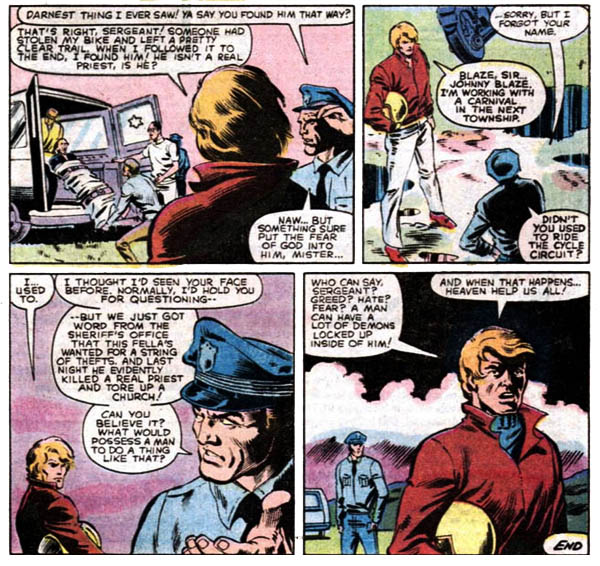
6 Comments
Totally agree. Best. Issue. of. Ghost. Rider. EVER. Marvel should’ve adapted this comic (and run) and the movie would’ve been an unbeatable hit.
Love this issue. Ghost Rider was my favorite title when I first started collecting and this is the best of the run!
Nice Issue. But for some reason, I prefer the “Pennance Stare” to “Cold Flames”. ;p
Nice Issue. But for some reason, I prefer the “Pennance Stare” to “Cold Flames”. ;p
The Penance Stare is nothin’ but a knockoff of the cold flame of Hellfire.
Strewth unto thy mater.
A relentless pursuit followed by a cold, burning skeletal hand clutching your soul and searing it with flames that leave your body untouched while the demon (well, not so much, it seems) cackles at your pain vs. …the Care Bear Glare? Indeed.
A very enjoyable Bronze Age comic that threw me for a loop with the twist! They don’t make ’em like that anymore.